新人教版高中英语必修2Unit 1 Cultural Heritage-Discovering Useful Structure教案二
-
- 页数:5页
- 字数:约 7877 字
- 大小:69.73KB
- 格式:.docx
- 版本:Office2016及以上版本
- 作者:Mu
Unit 1 CulturalHeritage-Discovering Useful Structure教案
Restrictive relative clauses(3)教学设计
This theme of thepart is “ Describe people or things in greater detail”. Students have learnedthe grammar(restrictive relative clauses) in Book 1, and further review andconsolidate its structure “prep+relative pronouns(which/whom)” and the relativeadverbs(when, where and why), besides students should understand its form,meaning and functions. In this section, students should be able to express thegrammar correctly in daily communication and in the writing.
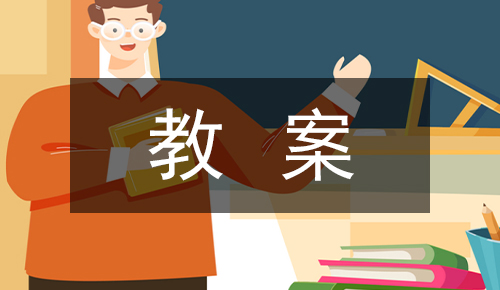
1.Review the basicusages of relative pronouns and adverbs of attributive clauses .
2.Learn to use somespecial cases about restrictive relative clauses.
3.Learn to writesentences with restrictive relative clauses flexibly according to the context.
1.Review the basicusages of relative pronouns and adverbs of attributive clauses .
2.Learn to use somespecial cases about restrictive relative clauses.
3.Learn tow ritesentences with restrictive relative clauses flexibly according to the context.
Step 1. Observe the following sentences, and mark the relative pronounsand the adverbs.
1.After listening to the scientists who had studied the problems, andcitizens who lived near the dam, the government turned to the United Nationsfor help.
2.Temples and other cultural sites were taken down piece by piece, andthen moved and put back together again in a place where they were safe from thewater.
Step 2 Practice
Please completethese sentences with relative pronouns and relative adverbs and answer thefollowing questions.
Questions: 1. What is the head noun ?
2. What relative words shouldbe used ?
3. What elements do they act inthese sentences ?
Practice:
1. There comes a time _______ the old must give a way to the new.
2. Water from the dam would likely damage a number of temples and destroycultural relics ______ were an important part of Egypt’s cultural heritage.
3. After listening to the scientists ________ had studied the problem, andcitizens _______ lived near the dam,...
4. Temples... and then moved and put back together again in a place ______ theywere safe from the water.
5. Not only had the countries found a path to the future_______ did not runover the relics of the past...
6. ...by UNESCO, which runs a programme _______ prevents world culturalheritage sites around the world from disappearing.答案:1. when(先行词:a time;关系副词;充当状语)
2. which/that(先行词:cultural relics; 关系代词; 充当主语)
3. who (先行词:the scientists; 关系代词; 充当主语)
who(先行词:citizens; 关系代词; 充当主语)
4. where(先行词:a place; 关系副词; 充当状语)
5. that(先行词:the future; 关系代词; 充当主语)
6. that(先行词:a programme; 关系代词; 充当主语)Step 3 Summary
head noun
Relative adverbs
Functions of relative adverbs
关系副词
time
when
表示时间状语
place
where
表示地点状语
reason
why
表示原因状语
Functions of head noun
Functions of relative pronoun
关系代词
O-S
先行词在主句中作宾语
关系代词在从句中作主语
I like a teacher who inspires his/her students.
O-O
先行词在主句中作宾语
关系代词在从句中作宾语
I like the book(that) you mentioned.
S-S
先行词在主句中作主语
关系代词在从句中作主语
He who makes no mistakes nothing.
S-O
先行词在主句中作主语
关系代词在从句中作宾语
The man (who) you met is my cousin.
Step 4 Recite classical sentences
1. Do not cut down the tree that gives youshake.(O-S) 不要忘恩负义。
2. You can do anything (that) you setyour mind to. (O-O) 世上无难事只怕有心人
3. All that glitters is notgold.(S-S) 发光的并不都是金子
4. Time (that) you enjoy wasting isnot wasted time.(S-O) 享受的时光并非虚度
5. Where there is a will, there is a way. 有志者,事竟成
6. Life is a tragedy when you feel. It is acomedy when you think.对于感受生活的人来说,生活是一场悲剧;对于思考生活的人来说,生活是一场喜剧Step 5 Practice
Rewrite thesentences using relative clauses.
1. He showed me a photo in his room. It was a photo of a famous cultural relicin Egypt.
The photo( that/which) he showed me in his room was of a famous cultural relicin Egypt.
2. The project team helped protect the national parks in the United Republic ofTanzania. It was formed by members from fifteen countries.
The project team which/that helped protect the national parks in the UnitedRepublic of Tanzania was formed by members from fifteen countries.
3. This temple was first built during the Qin Dynasty.
The time when this temple was first built was during Qin Dynasty.
4. We met a professional archaeologist at the entrance to the Great Pyramid. Heexplained to us the process of building such a difficult structure.
The professional archaeologist (who) we met at the entrance to the GreatPyramid explained to us the process of building such a difficult structure.
5. The documents about the cultural relics from overseas are under the desk. Ifound them yesterday.
The place where I found the documents about the cultural relics from overseasyesterday is under the desk.
6. Scientists worked together day and night to rescue the temple because theywanted to preserve it for the next generation.
The reason why scientists worked together day and night to rescue the temple isthat they wanted to preserve it for thenext generation.Step 6 Special cases
A. 关系词只能用that而不用which的情况1.当先行词为all,everything, nothing, anything, much等不定代词时。
Have you takendown everything that Mr Li said?
All that can be done has been done.
2.先行词被序数词或形容词最高级修饰时。
The first placethat they visited in London was the Big Ben.
This is themost delicious food that I have ever had.
3.先行词被all,every, no, the only, the very, the last等修饰时。
Ive read allthe books that are not mine.
The only thing that she could do was to go to the police for help.
I have foundthe very pen that I lost yesterday.
4.当先行词既指人,又指物时。
He made aspeech on the men and things that he had seen abroad.
B.“介词+关系代词”引导的定语从句
当关系代词在定语从句中作介词的宾语时,我们通常用“介词+关系代词”引导定语从句。如果指“人”,用“介词+whom”;如果指“物”,用“介词+which”;关系代词有时也用whose(作定语)。
选用介词的依据:
1.根据定语从句中谓语动词的搭配习惯(即固定短语)。
Yesterday wevisited the West Lake for which Hangzhou is famous.(be famous for“因……而出名”)
2.根据先行词的搭配习惯(约定俗成,不一定是短语)。
This is thecamera with which he often takes photos.(with camera“用照相机”)
The boss inwhose company Mr King worked heard about the accident.(in the boss company)
3.根据句子的意思来选择。
The colorlessgas without which we cannot live is called oxygen.
4.表示“所有”关系或“整体中的一部分”时,通常用介词of。
I have about 10books, half of which were written by Mo Yan.
注意:在定语从句中,有一些含介词的动词短语不可拆开使用,如look after, look for等不能把介词移至which或whom之前。
您可能喜欢的文档
查看更多
新人教版高中英语必修2Unit 3 The Internet-Discovering Useful Structure教案二
- 页数:4页
- |大小:118.87KB
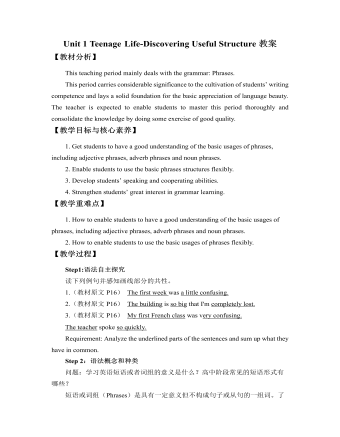
新人教版高中英语必修1Unit 1 Teenage Life-Discovering Useful Structure教案
- 页数:4页
- |大小:37.20KB
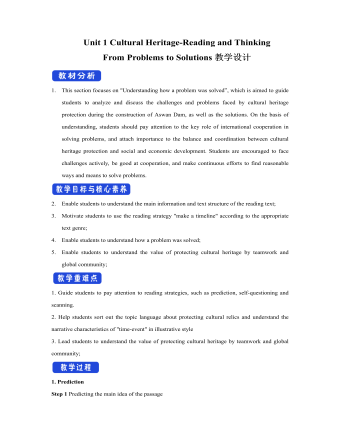
新人教版高中英语必修2Unit 1 Cultural Heritage-Reading and Thinking教案二
- 页数:4页
- |大小:69.68KB
热门课件教案
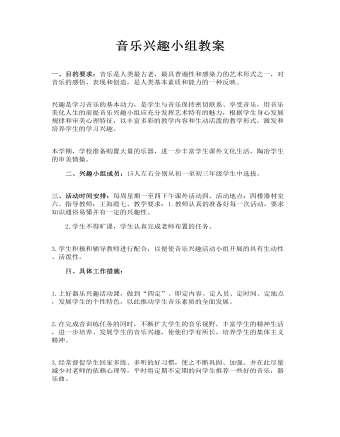
音乐兴趣小组教案
- 页数:5页
- |大小:89.58KB
- 课件教案
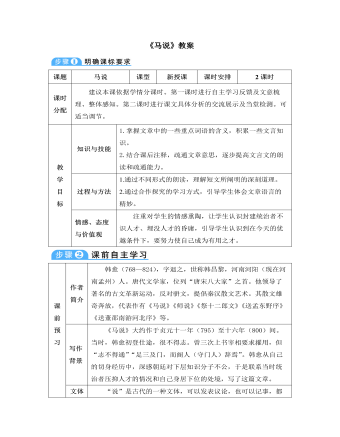
部编版语文八年级下册《马说》教案
- 页数:8页
- |大小:367.50KB
- 课件教案
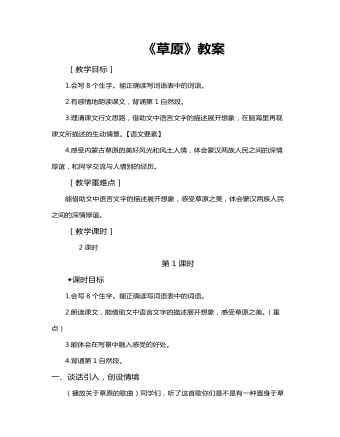
部编版六年级语文上册《草原》教案
- 页数:6页
- |大小:265.86KB
- 课件教案
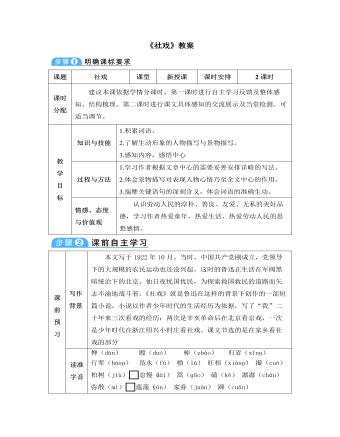
部编版语文八年级下册《社戏》教案
- 页数:8页
- |大小:340.00KB
- 课件教案
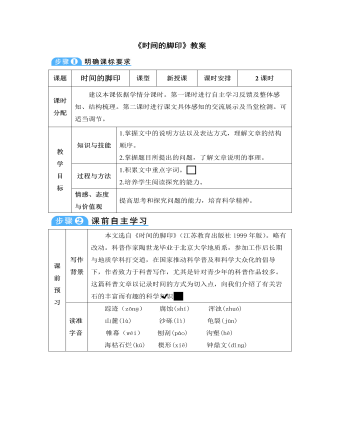
部编版语文八年级下册《时间的脚印》教案
- 页数:4页
- |大小:511.50KB
- 课件教案
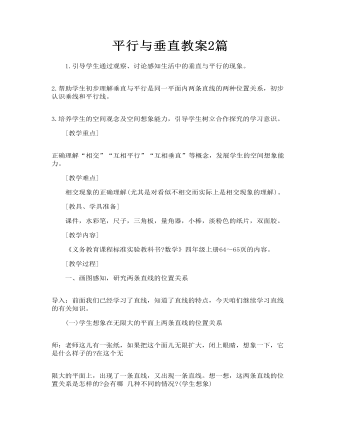
平行与垂直教案2篇
- 页数:9页
- |大小:101.04KB
- 课件教案
今日更新

精选高中生期末评语
- 页数:42页
- |大小:7M

××县招商局2024年上半年工作总结
- 页数:12页
- |大小:142.54KB

“四零”承诺服务创建工作总结
- 页数:5页
- |大小:39.83KB
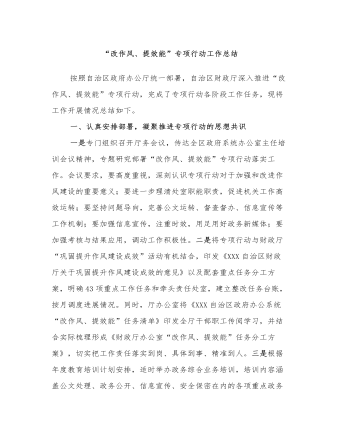
“改作风、提效能”专项行动工作总结
- 页数:6页
- |大小:139.05KB
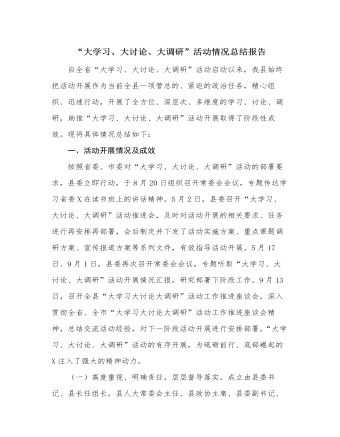
“大学习、大讨论、大调研”活动情况总结报告
- 页数:7页
- |大小:26.12KB
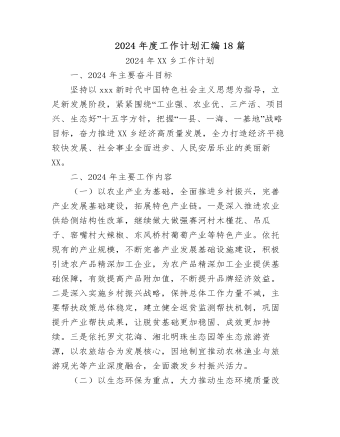
2024年度工作计划汇编(18篇)
- 页数:72页
- |大小:196.93KB









